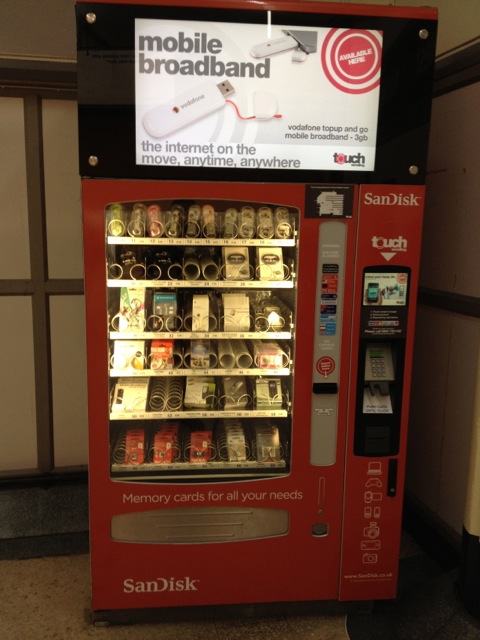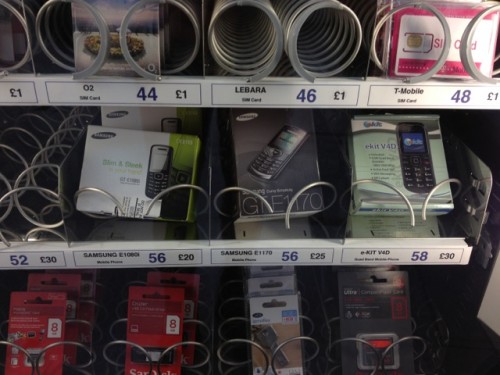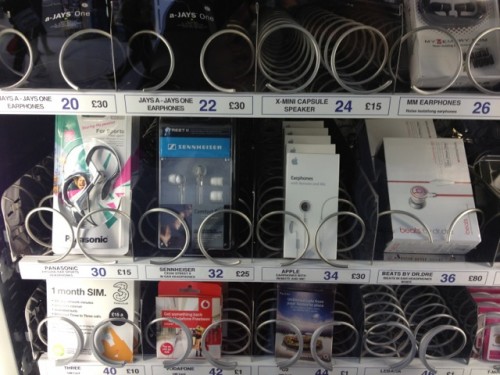
Observing vending machines
I’ve noticed more product vending machines appearing at transport hubs and in shopping centres. Vending machines have traditionally been associated with low value, consumable items, particularly drinks and confectionary. They supply an immediate need in places or at times where it would be otherwise uneconomical to provide human customer service. More recently, however, vending machines are stocking higher value items, from jewellery to mobile phones.
It reflects two customer trends: firstly, the ability to research purchases on a mobile device is making consumers more informed and confident enough to buy relatively high value items without speaking to a salesperson. Are digital accessories the convenience snacks of our increasingly virtual lives?
Secondly, there is an expectation of immediacy at all times. The notion of store ‘opening hours’ seems quaint and dated when supermarkets are open 24 hours a day, orders can be placed online in the middle of the night and vending machines sell you consumer electronics at the touch of a button. When was the last time you waited on the advice of a local merchant to buy a digital product? Indeed, how often do you actively avoid physical stores because you know the service is unlikely to meet your expectations?

This vending machine is located beside the ATMs on the way to platforms 15 – 19 at London’s Victoria Station (ironically, many years ago, this area used to be dedicated to BT’s fixed line payphones). It sells basic mobile phones, mobile broadband USB sticks, memory cards and a selection of headphones. Note that a pair of Apple iPhone headphones costs GBP 30, whereas an entire Samsung mobile phone costs GBP 20.
It is sponsored by Sandisk, the memory card manufacturer, and features two digital displays: one at the top (displaying an advertisement for mobile broadband in the photo above) and one above the keypad.
A selection of low end handsets:

iPhone accessories:

Keypad detail:

Here’s another example, this time embedded in the frontage of a jewellery store at the Westfield London Stratford shopping centre, located adjacent to the Food Court. It is worth noting the Food Court at Westfield remains open after the retail stores have closed. Hence the poster proclaims: “Want it, buy it, wear it…24/7 vending machine.”

Unfortunately, however, the piece of white A4 paper taped to the screen of the machine reads: “Vending machine not in use. please see in store for details. sorry for any inconvenience caused.” [The mis-capitalisation is their own].

It seems the process of explaining failure to the customer is still very much an analogue task, whether it be on paper or in store (which was also closed when I took the photo). Disappointment and mistrust seem to be amplified when the failure of something digital is flagged so untidily with paper.
This is the first in an occasional series sharing how MEX use observation and immersion to understand user experience. Some observations shape our consulting work, some simply confirm existing hypotheses and others go on to become major themes we explore through MEX Pathways at our events.

Interesting article. Have yet to spot any devices of this size or with such varied inventory, but wouldn’t be surprised if they’ve been reserved for the largest, busiest terminals in New York or Philadelphia (ie: the easter United States’ Baltimore – Boston corridor).
Vending machines are fascinating, aren’t they? Boxes that beckon us with various comforts, at all times of day. Still, modern ones tend to be sterile, earning poor marks for style and design. You can get cool stuff, but the overall experience is far from memorable.
That’s why Coca-Cola’s recent ‘Give the World a Coke” campaign caught our eye. Inspired by a memorable Coke ad from the 1970s, the idea was simple: expand on the classic ad’s theme, reminding us that even today Coke is a product tied withr friendship and good times.
The trick was in the methodology…
Google networked some vending machines with Coke’s on-line display ads. With a click or two, anybody reading the ad can send a free Coke to one of the machines. The result is brilliant, connecting people around the world and cementing the brand in warm sentiments.
Here’s the complete saga, from concept to execution. We sit on every phase of the project, including private moments a key team-member: Harvey Gabor, the legendary ad man who was one of the creative minds behind Coke’s 1971 “I’d Like to Teach the World to Sing” commercial.:
http://www.projectrebrief.com/coke/
…or, for those who are short on time (or attention-span), here’s the basic premise condensed into a 2-minute elevator pitch.:
http://www.youtube.com/watch?v=45Z-GevoYB8#!